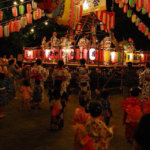Japanese Word Today - Bon Odori 盆踊り
Bon Odori (盆踊り), meaning simply Bon dance is a style of dancing performed during Obon. Originally a Nenbutsu folk dance to welcome the spirits of the dead, the style of celebration varies in many aspects from region to region. Each region has a local dance, as well as different music. The music can be songs specifically pertinent to the spiritual message of Obon, or local min’yo folk songs. Consequently, the Bon dance will look and sound different from region to region. Hokkaidō is known for a folk-song known as “Soran Bushi.” The song “Tokyo Ondo” takes its namesake from the capital of Japan. “Gujo Odori” in Gujō, Gifu prefecture is famous for all night dancing. “Gōshū Ondo” is a folk song from Shiga prefecture. Residents of the Kansai area will recognize the famous “Kawachi ondo.” Tokushima in Shikoku is very famous for its “Awa Odori,” or “fool’s dance,” and in the far south, one can hear the “Ohara Bushi” of Kagoshima.
The way in which the dance is performed is also different in each region, though the typical Bon dance involves people lining up in a circle around a high wooden scaffold made especially for the festival called a yagura. The yagura is usually also the bandstand for the musicians and singers of the Obon music. Some dances proceed clockwise, and some dances proceed counter-clockwise around the yagura. Some dances reverse during the dance, though most do not. At times, people face the yagura and move towards and away from it. Still some dances, such as the Kagoshima Ohara dance, and the Tokushima Awa Odori, simply proceed in a straight line through the streets of the town.
The dance of a region can depict the area’s history and specialization. For example, the movements of the dance of the Tankō Bushi (the “coal mining song”) of old Miike Mine in Kyushu show the movements of miners, i.e. digging, cart pushing, lantern hanging, etc. All dancers perform the same dance sequence in unison.
There are other ways in which a regional Bon dance can vary. Some dances involve the use of different kinds of fans, others involve the use of small towels called tenugui which may have colorful designs. Some require the use of small wooden clappers, or “kachi-kachi” during the dance. The “Hanagasa Odori” of Yamagata is performed with a straw hat that has been decorated with flowers.
The music that is played during the Bon dance is not limited to Obon music and min’yo; some modern enka hits and kids’ tunes written to the beat of the “ondo” are also used to dance to during Obon season.
The Bon dance tradition is said to have started in the later years of the Muromachi period as a public entertainment. In the course of time, the original religious meaning has faded, and the dance has become associated with summer.
To celebrate O-Bon in Okinawa, the eisa drum dance is performed instead.


